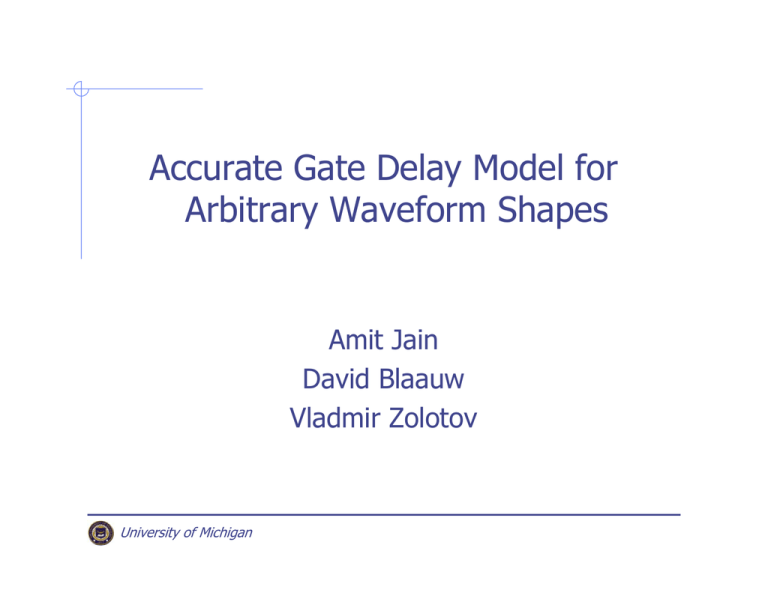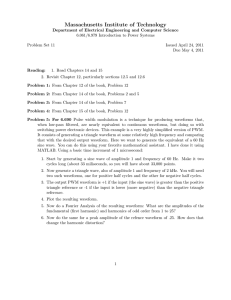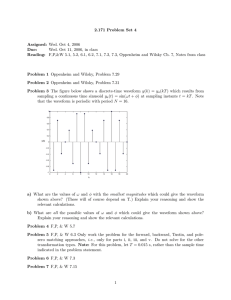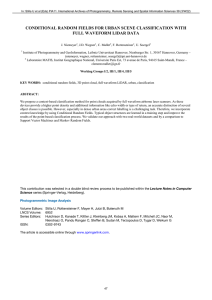Accurate Gate Delay Model for Arbitrary Waveform Shapes
advertisement

Accurate Gate Delay Model for
Arbitrary Waveform Shapes
Amit Jain
David Blaauw
Vladmir Zolotov
University of Michigan
Motivation
Static Timing Analyzers
Used to verify behavior of large
digital circuits
Core engine is circuit optimization
tools
Current Timing Analyzer
Cell Based Models
A
Fails to capture the shape of
complex the waveform
B
CELL
Q
Our Work
Methods for accurate modeling of
arbitrary gate input and output
waveforms
-2-
Outline
Motivation and Previous Work
Proposed Delay Modeling
Base Waveform Selection Method
Results
Conclusion
-3-
Cell Based Approach
Traditional Gate Delay
Model
2-D characterization tables for
20%-80% output slew and
50% output delay
Advantages
Simple and fast runtime
Disadvantages
Characterization effort.
(2-D input characterization
space with multiple process
corners)
Accuracy is a concern as we fail
to capture the shape of
complex waveforms
X
Cell
A
Input
Slope
(ns)
Output
Cap
Delay
(ns)
Output
Slope
(ns)
.2
2fF
.23
.15
.25
2fF
.28
.22
.2
4fF
.31
.19
.25
4fF
.35
.27
Delay
Volt
Slope
Time
-4-
Waveform Approximation
Ramp Approximation
Significant inaccuracy for non ramp
signals.
Worsens with as technology scales.
Occurrences of Non-Ramp
signals
Capacitive coupled nodes
Long routes with considerable
inductance (ringing)
Resistive shielding
Mutual inductance
Supply noise
Challenges
General method applicable to wide
range of waveform shapes
Maintain simplicity and efficiency of
traditional model
-5-
Other Proposed Approaches
M. Hashimoto, Y. Yamada, H. Onodera, “Equivalent
Waveform Propagation For Static Timing Analysis”, ICCAD
2003
Fitting for input waveforms using ramp using least quares
Output waveform not considered
C. Amin, F. Dartu, Y. Ismail, “Weibull Based Waveform
Model”,ICCAD 2003
Good match for monotone signals
Characterization Space increased with 3rd parameter
S. Nassif, E. Acar, “Advanced Waveform Models for the
Nanometer Regime”, TAU 2004
Interesting approach but does not discuss the application of
the approach with respect to gate delay model and timing
analysis
-6-
Outline
Motivation and Previous Work
Proposed Delay Modeling
Base Waveform Selection Method
Results
Conclusion
-7-
Stretching and Shifting Waveform
Traditional Fitting Approach
Adding delays in STA =
Shifting Waveform
Fitting Crossing times and
20% and Objective is to match
50% Vdd 80% Vdd Transition
time
Stretching
Ramp Shape Assumed
Time
Proposed Fitting Approach
Stretch and shift arbitrary
shape waveform
Using multiple waveforms to
model arbitrary waveform
shapes
Volts
Minimize the weighted least
square difference
(Considers entire waveform)
Shifting
Volts
Slope = Stretch Factor
Time
-8-
Proposed Timing Analysis
Multiple base
waveforms
D
C
A B
a
Cell
Evaluating fit of
each base
waveform usingA
shift and stretch
Selection of the
best base
Waveform.
b
c
d
Cell
a
Stretching
Factor
Output
Cap
Output
Wave
Stretching
Factor
Shifting
Factor
.85
2fF
a
1.23
-20.8
.95
2fF
b
1.10
-30.2
1
2fF
a
1.3
-24.6
-9-
Closure Property
Use the same set of base waveforms for input and output
waveform modeling
For Local Interconnects
New waveform is not constructed
but shift and stretch factors
along with the base waveform
type are directly propagated
Fast, and runtime comparable to
traditional STA
C
B
A
For Global Interconnects
Shape of the waveform
changes due to interconnect
and hence new waveform must
be re-fitted
Accuracy much better than
traditional STA
D
C
A
B
Cell
Cell
A
D
Cell
-10-
Proposed Representation of a Waveform
Proposed Waveform
Representation
Specifying a waveform as vector of
n time points
[T] = { t1, t2, t3, t4, t5, …….. tn }
where ti is the time that the
waveform crosses voltage i (Vdd/n)
[R] = ta + s.[T] where
s = Stretching factor
ta = Shifting
Which set of base waveforms is best to use in timing analysis?
-11-
Outline
Motivation and Previous Work
Proposed Delay Modeling
Base Waveform Selection Method
Results
Conclusion
-12-
Proposed Methodology
Proposed Methodology (Objectives)
Minimum number of base waveforms for given error threshold
Select arbitrary number of base waveforms depending upon
desired accuracy
Under closure optimal Selection of Base Waveforms maps
to a 3D covering problem which is infeasible
Proposed Simplified Method
Construct set of input base waveforms
Generate large set of candidate waveforms
Use candidate waveforms as possible base waveforms
Generate an error matrix
Generate cover matrix
Solve the covering problem to select required base waveforms
Select output base waveforms from input base waveforms
-13-
Generating Candidate Waveforms
Noisy Waveform
Generation of Candidate
Waveform (Wc)
Base Waveforms (Wb) are selected
from Candidate Waveform
Capacitively coupled nodes’
Waveforms
Inductive Ringing Waveforms
Mutually Inductive Waveforms
-14-
Generation of Error Matrix
Candidate Waveform
Base Waveform
[H] = r + s x [T]
Any waveform [H] can be represented as
shifted and stretched version of a base
waveform.
n* (n-1) spice simulation where n is the
number of candidate waveform waveform
0ps
5ps
4ps
8ps
0ps
7ps
4ps
6ps
0ps
Volts
Max
Time
-15-
Generation of Cover Matrix.
Candidate Waveform
Threshold ε
Base Waveform
If C(i,j) = 0 if E(i,j) > ε (= 4 )
else C(i,j) = 1
1
0
1
0
1
0
1
0
1
Cover Matrix
Unate Covering Problem
Select a set of rows such that each column has at least
one “1” in a selected row
Solving the Unate Covering Problem gives us the base
waveform set
Efficient heuristics available
-16-
Outline
Motivation and Previous Work
Proposed Delay Modeling
Base Waveform Selection Method
Results
Conclusion
-17-
Results
Ramp Waveform
Decrement
of error
Five
from 93.3ps
Waveform
to 44.6ps
without
increasing
characterization
21ps
space
Proposed Approach
Output
Capacitance
Least
Square
Methods
10%-90%
Fitted
Single
Waveform
Two
Waveform
10fF
64.4ps
93.3ps
43.3ps
38ps
5fF
59.3ps
91.6ps
42.0ps
37.5ps
31ps
2fF
64.4ps
90.6ps
44.6ps
37ps
28ps
Maximum
Matrix
64.4ps
93.3ps
44.6ps
38ps
34ps
Comparison between Proposed and Traditional Approaches
These experiments were done with 381 candidate waveforms out of which 200 were
capacitively coupled, 179 inductive ringing and 2 were mutually inductive noisy
waveform
-18-
Threshold Graph for the Input Waveform
Threshold Graph for Noisy Signals with different Loadings
50
Maximum Output
45
Output 10fF
40
Output 5fF
Ouptut 2fF
Error in ps
35
30
25
20
15
10
5
0
0
2
4
6
8
10
Number of Base Waveforms
Threshold Graph for Different Loading for input noisy waveforms
As the Maximum allowable error increases the number of waveforms decreases
-19-
Comparison Across Library Cells
Gate Type
Ramp Waveforms
Proposed Waveforms
10%-90%
Fitted (ps)
Linear
Fitted (ps)
Single
Waveform
(ps)
Two
Waveform
(ps)
Five
Waveform
(ps)
NAND
85.1
59.8
41
33
22
NOR
79.8
57.2
37.9
31
23
AND
108.2
56.7
33.9
21
7
OR
106.6
55.9
33
27
8
Inverter
93.3
64.4
43.3
38
21
Maximum
106.6
64.4
43.3
39
34
Comparison between the traditional approach and proposed approach for
different gates from a library with a constant output loading
-20-
Threshold Graph Across Library Cells
AND Gate 10fF
OR Gate 10fF
NAND Gate 10fF
NOR Gate 10fF
Inverter 10fF
Maxim um Analysis
45
Error in picoseconds
40
35
30
25
20
15
10
5
1
2
3
4
5
Num ber of Base W avform s
Threshold Graph combining all types of Gates
-21-
Error and Threshold Graph for Output Waveforms
Gate
One
Waveform
Two
Waveform
Five
Waveform
And
20.3ps
13.4ps
9.1ps
30
8.9ps
25
NOR
21.4ps
21.1ps
13.7ps
14.1ps
9.4ps
NAND
22.3ps
13.9ps
9.2ps
Inverter
25.1ps
15.2ps
9.7ps
Max.
Across
Gates
Maximum Output
Output 10f
Output 5f
Output Error in ps
OR
Output Waveform Threshold Graph
Output 2f
20
15
10
5
0
25.8ps
15.5ps
10.1ps
Error Waveform at Output with Closure
0
1
2
3
4
5
6
Numbe r of Wav e forms
Threshold Graph
-22-
Verification
Verification Results
2781 Waveforms generated
to test the accuracy of the
proposed gate delay model
A single base waveform was
used
Maximum error predicted
using the approach was
43.4ps
Actual maximum error using
the test waveforms with spice
was 44.4ps
The introduced error of about
a Pico-second is attributed to
the interpolation error
-23-
Conclusion
In this work we have proposed a new methodology
for gate delay model for arbitrary waveform shapes
that traditionally were difficult to model with simple
ramp approximation without exponentially increasing
input characterization space
Using this approach the maximum error decreases
from 93.3ps to 43.3ps by selecting only a single base
waveform
This cost of fitting is generally much less than that of
signal convolution used for inter-connect simulation
Also, the cost of selecting the base waveform is
amortized for the entire library and is a one-time cost
-24-
Questions?
-25-




